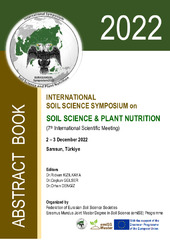Приказ основних података о документу
Direct sowing of rainfed winter wheat and in arid region of South Kazakhstan
| dc.creator | Saljnikov, Elmira | |
| dc.creator | Turebayeva, Sagadat | |
| dc.creator | Zhapparova, Aigul | |
| dc.creator | Milinković, Mira | |
| dc.creator | Ugrenović, Vladan | |
| dc.creator | Miladinović, Vladimir | |
| dc.creator | Buntić, Aneta | |
| dc.date.accessioned | 2024-04-12T07:27:21Z | |
| dc.date.available | 2024-04-12T07:27:21Z | |
| dc.date.issued | 2023 | |
| dc.identifier.isbn | 978-605-63090-7-6 | |
| dc.identifier.uri | http://RIVeC.institut-palanka.rs/handle/123456789/886 | |
| dc.description.abstract | To feed the ever-growing population of the Earth, it is necessary to obtain higher grain yields per unit area. This requires intensive exploitation of arable land against the background of a reduction in their area, which ultimately leads to soil degradation. Currently, about 75% of the territories of the Republic of Kazakhstan are subject to an increased risk of desertification, more than 30.5 million hectares are subject to wind and water erosion, and 54% of these territories are located in the southern part of the country. In the arid climate of southern Kazakhstan, the main limiting factor of crops is the lack of soil moisture and availability of nutrients. In addition in recent few decades the cost of fossil fuels and lubricants are steadily growing. Resource saving technologies such as direct sowing, can significantly contribute in the problems of soil moisture loss, soil degradation due to tillage, wind and water erosion, CO2 emission due to mineralization etc. The effect of different doses and terms of application of growth stimulators, micronutrients, bio-fertilizers and mineral fertilizers, as well as their economic efficiency, was studied in ten variables of rainfed winter wheat grown with zero tillage technology. The use of a combination of growth stimulators and microfertilizers produced the highest grain yield and was the most cost-effective. The greatest value of the nominal net profit of 223.25 euro and 244.10 euro from one hectare was provided and calculated with the recommended target grain yield of 2.0 t/ha dose of mineral fertilizers, respectively; however, the production cost of one ton of grain in these treatments was also highest. Further research is continuing with a wider range and combination of amendments and various crops in a rainfed no-till winter wheat farm in southern Kazakhstan. The results have shown that in dry and hot climate conditions with a deficit moisture regime, direct sowing of rainfed winter wheat can be successfully applied provided an appropriate combination, dosage and timing of fertilizers and crop protection chemicals are applied | sr |
| dc.language.iso | en | sr |
| dc.publisher | Federation of Eurasian Soil Science Societies | sr |
| dc.rights | openAccess | sr |
| dc.source | International Soil Science Symposium on “Soil science & plant nutrition” 2 – 3 December 2022, Samsun, Türkiye | sr |
| dc.subject | direct sowing | sr |
| dc.subject | rainfed winter | sr |
| dc.subject | wheat | sr |
| dc.subject | South Kazakhstan | sr |
| dc.title | Direct sowing of rainfed winter wheat and in arid region of South Kazakhstan | sr |
| dc.type | conferenceObject | sr |
| dc.rights.license | ARR | sr |
| dc.citation.spage | 4 | |
| dc.identifier.fulltext | http://RIVeC.institut-palanka.rs/bitstream/id/2831/bitstream_2831.pdf | |
| dc.identifier.rcub | https://hdl.handle.net/21.15107/rcub_rivec_886 | |
| dc.type.version | publishedVersion | sr |


